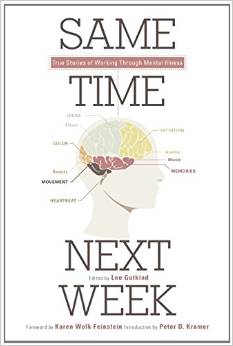Review by Jules Barrueco
 Obsessive-compulsive disorder constitutes more than a tendency to organize meticulously your email folders, or always put the remote in the same place on the table. Actual OCD can mean living with a dictator in your head who barks out 500 to 1000 commands per day, “a conservative estimate” according to Kurt Warner, the host of one such tyrant.
Obsessive-compulsive disorder constitutes more than a tendency to organize meticulously your email folders, or always put the remote in the same place on the table. Actual OCD can mean living with a dictator in your head who barks out 500 to 1000 commands per day, “a conservative estimate” according to Kurt Warner, the host of one such tyrant.
Warner wrote one of 18 essays contained in editor Lee Gutkind’s new anthology, Same Time Next Week: True Stories of Working Through Mental Illness (InFact Books, 2015). The book attaches clinical terms like bipolar disorder and schizophrenia to real people with names, families, and personalities, and at times, with advanced degrees and licenses to treat others. This collection, which had the potential to be cold and clinical, is bursting with warmth and inspiration.
The essays generally fall into three categories: patients discussing their illnesses, therapists discussing their patients, and a combination involving past-patients as current therapists. The common theme is uncommon approaches to healing. Beyond that, however, “common” is not a word that describes these exceptional stories.
Often more captivating than the first person accounts of mental illnesses are the narratives of those trying to cure them. For example, J. Timothy Damiani, or “Dr. D,” endears readers to his patient, “Mr. Newman,” who was misdiagnosed with schizophrenia. As Dr. D tracked Newman’s progress through their recurring card games – at times a haphazard combination of gin, crazy eights, and war – we watch him come back to life and feel elated for the caring new man who emerged from the dark.
Like Dr. D’s card games, other treatment methods evolved instinctively. When Tom Mallouk’s patient, Steve, broke into Tae Kwon Do mid-session, Mallouk stood up and asked Steve for a lesson.
When Dan Tomasulo met a teenage girl so committed to poor hygiene that he could not tolerate her odor indoors, he took her outside and treated her while on their feet.
When Miriam Mandel Levi met Jeannie, a patient who gave up speech, swallowed pencils, and tore flesh from her own arms like a Rottweiler, Levi treated Jeannie’s pervasive refusal syndrome in a nontraditional way with traditional speech therapy.
And when Ella Wilson struggled to let go of her past, she and her therapist traveled upstate, grabbed a shovel, dressed in black, hiked through the dark woods, and literally buried the painful pieces. In fact, Wilson’s captivating, smart, and often funny account of her journey – embarked on with her mind and with her feet – is, perhaps, the strongest piece in the collection.
These writers do not, however, merely explain the treatment in technical terms. The characters are portrayed with such humanity that you root for the troubled teens, ache for the ailing men, and laugh with the pained woman as she traipses through the wilderness.
The book has few drawbacks. One therapist’s piece reads more like a case study than creative nonfiction, and the narrator of one patient’s essay feels awfully unreliable. Occasionally the prose is weak or a story is long. But those are the exceptions in an otherwise well-written, moving, marvelous book.
“Enjoyable” is a curious way to describe the essays, yet I enjoyed them immensely. Gutkind’s collection beautifully captures the pain of the mentally ill, the pressure on those who heal them, and the progress that can result from the right combination of hope, determination, and an unconventional leap – or hike – into the unknown.
Rating: 4/5 stars
[boxer set=“barrueco”]

